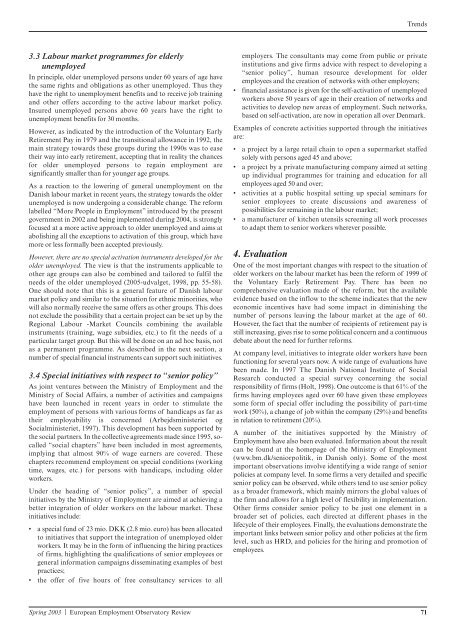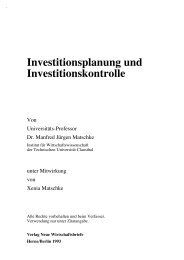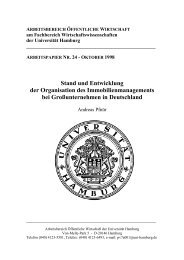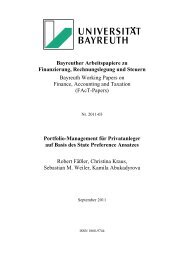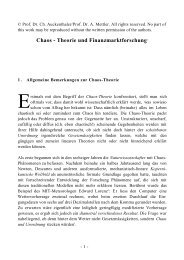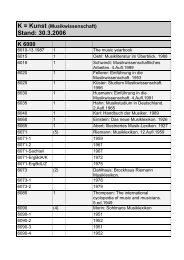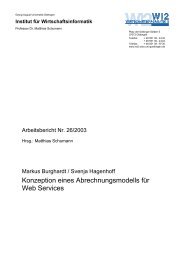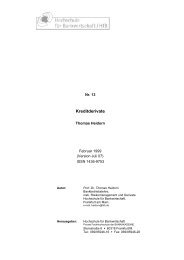FRANCE The
FRANCE The
FRANCE The
You also want an ePaper? Increase the reach of your titles
YUMPU automatically turns print PDFs into web optimized ePapers that Google loves.
3.3 Labour market programmes for elderly<br />
unemployed<br />
In principle, older unemployed persons under 60 years of age have<br />
the same rights and obligations as other unemployed. Thus they<br />
have the right to unemployment benefits and to receive job training<br />
and other offers according to the active labour market policy.<br />
Insured unemployed persons above 60 years have the right to<br />
unemployment benefits for 30 months.<br />
However, as indicated by the introduction of the Voluntary Early<br />
Retirement Pay in 1979 and the transitional allowance in 1992, the<br />
main strategy towards these groups during the 1990s was to ease<br />
their way into early retirement, accepting that in reality the chances<br />
for older unemployed persons to regain employment are<br />
significantly smaller than for younger age groups.<br />
As a reaction to the lowering of general unemployment on the<br />
Danish labour market in recent years, the strategy towards the older<br />
unemployed is now undergoing a considerable change. <strong>The</strong> reform<br />
labelled “More People in Employment” introduced by the present<br />
government in 2002 and being implemented during 2004, is strongly<br />
focused at a more active approach to older unemployed and aims at<br />
abolishing all the exceptions to activation of this group, which have<br />
more or less formally been accepted previously.<br />
However, there are no special activation instruments developed for the<br />
older unemployed. <strong>The</strong> view is that the instruments applicable to<br />
other age groups can also be combined and tailored to fulfil the<br />
needs of the older unemployed (2005-udvalget, 1998, pp. 55-58).<br />
One should note that this is a general feature of Danish labour<br />
market policy and similar to the situation for ethnic minorities, who<br />
will also normally receive the same offers as other groups. This does<br />
not exclude the possibility that a certain project can be set up by the<br />
Regional Labour -Market Councils combining the available<br />
instruments (training, wage subsidies, etc.) to fit the needs of a<br />
particular target group. But this will be done on an ad hoc basis, not<br />
as a permanent programme. As described in the next section, a<br />
number of special financial instruments can support such initiatives.<br />
3.4 Special initiatives with respect to “senior policy”<br />
As joint ventures between the Ministry of Employment and the<br />
Ministry of Social Affairs, a number of activities and campaigns<br />
have been launched in recent years in order to stimulate the<br />
employment of persons with various forms of handicaps as far as<br />
their employability is concerned (Arbejdsministeriet og<br />
Socialministeriet, 1997). This development has been supported by<br />
the social partners. In the collective agreements made since 1995, socalled<br />
“social chapters” have been included in most agreements,<br />
implying that almost 90% of wage earners are covered. <strong>The</strong>se<br />
chapters recommend employment on special conditions (working<br />
time, wages, etc.) for persons with handicaps, including older<br />
workers.<br />
Under the heading of “senior policy”, a number of special<br />
initiatives by the Ministry of Employment are aimed at achieving a<br />
better integration of older workers on the labour market. <strong>The</strong>se<br />
initiatives include:<br />
• a special fund of 23 mio. DKK (2.8 mio. euro) has been allocated<br />
to initiatives that support the integration of unemployed older<br />
workers. It may be in the form of influencing the hiring practices<br />
of firms, highlighting the qualifications of senior employees or<br />
general information campaigns disseminating examples of best<br />
practices;<br />
• the offer of five hours of free consultancy services to all<br />
Spring 2003 | European Employment Observatory Review 71<br />
Trends<br />
employers. <strong>The</strong> consultants may come from public or private<br />
institutions and give firms advice with respect to developing a<br />
“senior policy”, human resource development for older<br />
employees and the creation of networks with other employers;<br />
• financial assistance is given for the self-activation of unemployed<br />
workers above 50 years of age in their creation of networks and<br />
activities to develop new areas of employment. Such networks,<br />
based on self-activation, are now in operation all over Denmark.<br />
Examples of concrete activities supported through the initiatives<br />
are:<br />
• a project by a large retail chain to open a supermarket staffed<br />
solely with persons aged 45 and above;<br />
• a project by a private manufacturing company aimed at setting<br />
up individual programmes for training and education for all<br />
employees aged 50 and over;<br />
• activities at a public hospital setting up special seminars for<br />
senior employees to create discussions and awareness of<br />
possibilities for remaining in the labour market;<br />
• a manufacturer of kitchen utensils screening all work processes<br />
to adapt them to senior workers wherever possible.<br />
4. Evaluation<br />
One of the most important changes with respect to the situation of<br />
older workers on the labour market has been the reform of 1999 of<br />
the Voluntary Early Retirement Pay. <strong>The</strong>re has been no<br />
comprehensive evaluation made of the reform, but the available<br />
evidence based on the inflow to the scheme indicates that the new<br />
economic incentives have had some impact in diminishing the<br />
number of persons leaving the labour market at the age of 60.<br />
However, the fact that the number of recipients of retirement pay is<br />
still increasing, gives rise to some political concern and a continuous<br />
debate about the need for further reforms.<br />
At company level, initiatives to integrate older workers have been<br />
functioning for several years now. A wide range of evaluations have<br />
been made. In 1997 <strong>The</strong> Danish National Institute of Social<br />
Research conducted a special survey concerning the social<br />
responsibility of firms (Holt, 1998). One outcome is that 61% of the<br />
firms having employees aged over 60 have given these employees<br />
some form of special offer including the possibility of part-time<br />
work (50%), a change of job within the company (29%) and benefits<br />
in relation to retirement (20%).<br />
A number of the initiatives supported by the Ministry of<br />
Employment have also been evaluated. Information about the result<br />
can be found at the homepage of the Ministry of Employment<br />
(www.bm.dk/seniorpolitik, in Danish only). Some of the most<br />
important observations involve identifying a wide range of senior<br />
policies at company level. In some firms a very detailed and specific<br />
senior policy can be observed, while others tend to use senior policy<br />
as a broader framework, which mainly mirrors the global values of<br />
the firm and allows for a high level of flexibility in implementation.<br />
Other firms consider senior policy to be just one element in a<br />
broader set of policies, each directed at different phases in the<br />
lifecycle of their employees. Finally, the evaluations demonstrate the<br />
important links between senior policy and other policies at the firm<br />
level, such as HRD, and policies for the hiring and promotion of<br />
employees.


